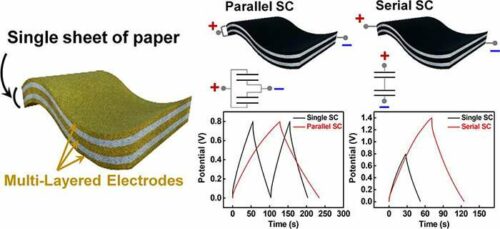Researchers have proposed a new way to fabricate flexible capacitors for wearable devices overcoming the problems with stacked sheets.

Wearable devices are a type of smart devices which are meant to eliminate the need for bulky devices that makes simple processes sluggish. This can only happen when the embedded devices like sensors are smart enough to perform the desired task on their own without relying on an external memory or processing unit. The hardware it is made up of should not become its limitation, the stiffness of a material or the electronics itself should not be a limitation.
A group of researchers from Chung-Ang University, led by Professor Suk Tai Chang and Associate Professor Inho Nam, recently fabricated a structure comprising multi-layer electrodes vertically integrated within a single sheet of paper. The novel design overcomes the problems associated with stacked sheets while retaining the inherent advantages of a paper-based substrate.
A water-repellent paraffin wax layer was printed and heated on both sides of a filter paper. This formed a water-friendly channel surrounded by a wax barrier within the paper. Following this, the paper was successively dipped in gold nanoparticle and gold enhancement solutions, which penetrated the channel via capillary action, resulting in a gold electrode in the middle of the paper. Similar electrodes were then fabricated on top and bottom surfaces of the paper to obtain a multi-layer electrode platform.
Researchers then deposited manganese dioxide—an active electrode material—on the gold-paper electrode, which was then immersed in a polyvinyl alcohol–sodium sulfate gel electrolyte solution to complete the design. After the gel had solidified, they characterized the manganese dioxide-gold-paper electrodes using various electrochemical measurement techniques, such as cyclic voltammetry, galvanostatic charge and discharge, and electrochemical impedance spectroscopy.
The supercapacitor design showed a low electrical resistance, high foldability, and good mechanical strength. Manganese dioxide enhanced its active surface area, which further boosted the electrochemical performance. Additionally, the supercapacitor demonstrated high energy storage with maximum areal energy and power densities of 13.73 μW-hr-cm-2 and 1.6 mW-cm-2, respectively. Moreover, it retained its storage capacity even after undergoing 6000 charge-discharge cycles.
Researchers say that their method of fabrication circumvents most fabrication challenges related to two-dimensional energy storage sheets. They also believe that their study will guide the future fabrication of paper-based electronics with more multi-layered electrodes.
Reference : Yeon Woo Kim et al, Vertical integration of multi-electrodes inside a single sheet of paper and the control of the equivalent circuit for high-density flexible supercapacitors, Chemical Engineering Journal (2022). DOI: 10.1016/j.cej.2022.140117






